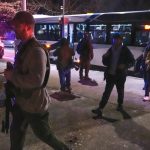Facing mounting flight disruptions at Newark Liberty International Airport, United Airlines is urging the Federal Aviation Administration to reinstate flight caps to alleviate congestion and improve safety.
The call for reform came just hours after another air traffic control glitch at the airport early Friday morning, when radar screens went dark and controllers briefly lost the ability to see or communicate with aircraft in the area, marking the second such incident in recent weeks.
The airline began cutting about 35 daily flights out of Newark on Saturday, attributing the decision to persistent shortages in air traffic control staffing and equipment malfunctions.
United is launching a pressure campaign, urging federal officials to go further by asking the FAA to reclassify Newark as a Level 3 slot-controlled airport, a move that would limit scheduled flights to 77 per hour, the maximum the airport can safely accommodate, according to the agency. United CEO Scott Kirby argued that the FAA should shift to 48 flights hourly amid runway construction.
“Every other large capacity constrained airport in the world uses slots to make sure that the number of scheduled flights in any given hour does not exceed the airport’s maximum capacity,” Kirby wrote in a letter to United employees. Newark “is the only large airport in the world that no longer has this basic common-sense rule.”
Newark accommodates roughly 1,000 flights each day, split between about 500 arrivals and 500 departures. United accounts for nearly 400 of those daily departures, serving 130 domestic and international destinations.
The FAA designates airports with inadequate infrastructure to handle traffic as “Level 3,” allowing it to impose slot restrictions to manage congestion. Currently, only three U.S. airports fall under this classification: New York’s LaGuardia and John F. Kennedy International airports and Ronald Reagan Washington National Airport. At these airports, the FAA allocates specific takeoff and landing slots to airlines. The FAA reclassified Newark from a Level 3 to a Level 2 airport in 2016.
At Level 3 airports, the FAA issues designated “slots” that grant airlines permission for specific takeoffs and landings. Newark, by contrast, is categorized as a Level 2 airport, one of just four in the U.S. Under this classification, the FAA does not impose flight limits but instead works collaboratively with airlines to coordinate schedules and reduce congestion.
During a call with reporters on Friday, United Airlines pushed back at critics who argue that reinstating Level 3 slot controls could entrench the airline’s dominance at Newark. The airline emphasized that it is flying less now than it did in 2016 and 2017 and is cutting back on flights at the airport far more than any other airline.
Without slot controls, Kirby argues that other airlines will simply backfill their cuts with new flights of their own unless the FAA steps in. The FAA did not respond to a request for comment from the Washington Examiner.

White House press secretary Karoline Leavitt confirmed that a brief system glitch Friday morning in Newark was linked to the same telecom and software issues reported last week.
“Everything went back online after the brief outage, and there was no operational impact,” Leavitt said during a briefing Friday afternoon.
“The DOT and the FAA are working to address this technical issue tonight to prevent further outages, as well as install new fiber from New York airport to Philadelphia, and the goal is to have the totality of this work done by the end of the summer,” she added.
Leavitt said the incident underscores the importance of a sweeping plan unveiled by Transportation Secretary Sean Duffy on Thursday to overhaul the nation’s air traffic control system.
The eight-page proposal outlines a nationwide reform of the air traffic control system, calling for the replacement of outdated radio communication tools with modern systems, swapping copper cables for high-speed fiber optics, and transitioning flight data management to fully digital platforms. It also prioritizes renovating aging control facilities and expanding advanced weather and surveillance technologies to underserved regions such as Alaska and the Caribbean.
However, the plan omits critical information on costs and funding sources for the equipment needed to upgrade a system the FAA has long struggled to modernize. Moving forward with the proposals will require congressional approval to secure the necessary funding.
Last year, the FAA shifted oversight of Newark’s airspace to Philadelphia in an effort to ease staffing shortages and manage heavy air traffic in the New York region. The switchover has been plagued by technical glitches and repeated failures in backup systems.
Senate Minority Leader Chuck Schumer (D-NY) urged swift intervention to resolve critical aviation coordination failures between New York and Philadelphia, warning that delayed infrastructure upgrades are unacceptable given the high volume of flights in the region.
“Enough is enough,” Schumer said in a statement. “The connection between New York air space and the Philadelphia air traffic control center must be fixed now. The back up system that is not working must be fixed. Now.
“This is an air travel safety emergency that requires immediate and decisive action, not a promise of a big, beautiful unfunded overhaul that will take years to begin to implement. The skies over New York City are some of the busiest in the world. This cannot happen again.”
SEAN DUFFY UNVEILS FAA PLAN TO MODERNIZE AIR TRAVEL WITH TRUMP ON SPEAKERPHONE
At a Friday news conference, Rep. Josh Gottheimer (D-NJ) pointed to outdated technology and a severe shortage of air traffic controllers as key factors behind disruptions at Newark. He noted that only around 20 controllers are on duty, far short of the 60-plus needed to operate efficiently.
“Our region is a key economic artery for our country,” Gottheimer said. “Yet this region … one of the busiest air spaces in the world, as I mentioned, is running off a tower that’s full of copper wire dating back to the 1980s with outdated and inefficient technology.”
























